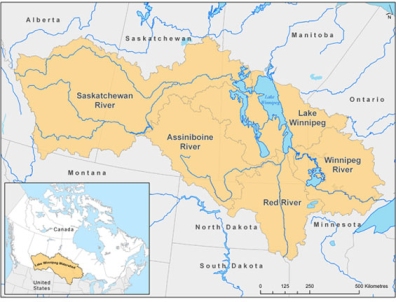This guest blog post was written by Jessica Rehmann, a high school intern with the Water Rocks! team. Jessica is beginning her senior year at Ames High School this fall, where she is actively involved with music (playing saxophone in band/jazz band), athletics (cross country/ track), and more. And no, you are not seeing double… Emily Rehmann (previous blogger and summer intern) and Jessica Rehmann are identical twins!
As a summer intern with Water Rocks! and Iowa Learning Farms, I have been traveling around the state with the Conservation Station to many county fairs. Our goal is to educate fair attendees about water quality and watersheds with the Enviroscape model, the Rainfall Simulator, the Learning Lab trailer posters and videos, and the Poo Toss game. We also sometimes have free popcorn for the people who visit our station! I have enjoyed teaching kids (and adults!) about the Enviroscape and Poo Toss game.

Teaching the Enviroscape at the Dallas County Fair!
With the Enviroscape model, we want to help people see the effects of pollution and rainfall within a watershed. Because the Enviroscape is a three-dimensional model of a watershed, we start by discussing what a watershed is. To make the point that a watershed is an area of land where all the water drains to a common point, I ask kids to make a cup with their hands to represent the watershed and a landscape (or as fellow intern Megan calls it, a “handscape”). We choose places on our “handscape” for our homes, the fairgrounds, and maybe a store. Next we pretend-rain on our hands and determine where the water would go. The kids realize that in their watershed, the water that rains on their houses and the water that rains on the fair would all go to one place, the lowest point on the landscape. In the Enviroscape watershed, they guess that the common point that water drains to is the lake.
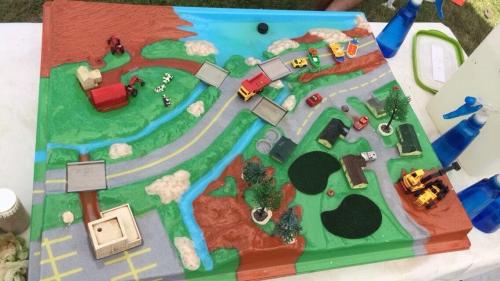
An overhead view of the Enviroscape watershed model, clean and ready for teaching.
Next, we add pollution to the watershed. I invite the kids to take a tour through the watershed first to get an idea of where pollution could be. The model includes a neighborhood, forest, factory, roads, vehicles, construction site, golf course, farm, pasture, rivers, and lake. We add loose soil (the biggest polluter of water in Iowa), fertilizer, pesticides/herbicides, oil, and manure to the watershed. The kids will often guess what the powders representing the pollutants are, and they are surprisingly accurate, especially with the lime Kool-Aid representing fertilizer!
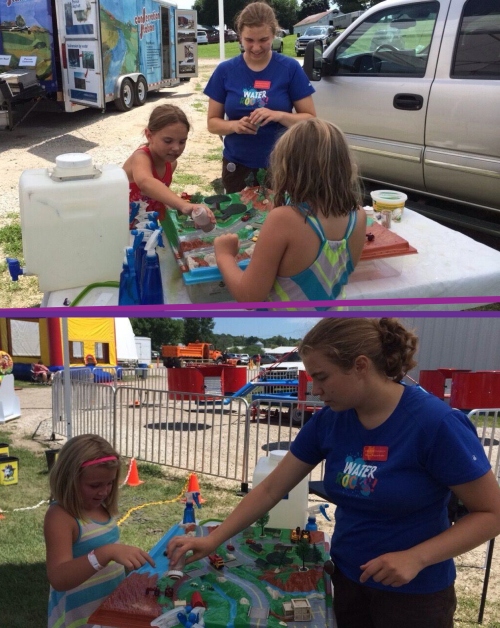
Megan Koppenhafer, fellow intern, adding loose soil to the watershed, with an eager repeat visitor (in stripes), at the Audubon County Fair.

Jessica Rehmann adding oil to the landscape (Brian Stout looks on) at the Dallas Co. Fair.
After we have added pollutants to the watershed, the kids summon their inner rain clouds and make a big rainstorm on the Enviroscape with squirt bottles. As the rain hits the ground, it carries the pollutants with it as everything runs downhill to the lake. The kids are often surprised that all the pollutants run into the lake and cause the lake to become disgusting and polluted. They declare that they would not like to drink or swim in the water and that the plants and animals in and around the lake would not be happy.
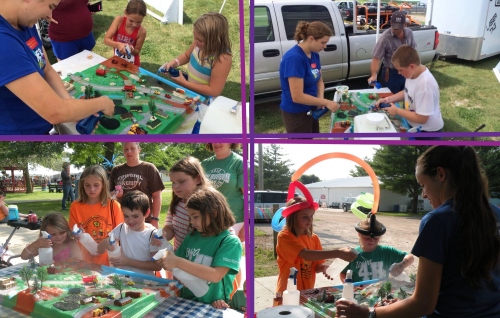
Making it rain on the Enviroscape with Megan (above) and Jessica (lower right)! The lake on the top left is definitely polluted (see clean lake picture above to compare).
Then we discuss what we could do differently to help the water in the watershed stay cleaner. The kids can often come up with fixing leaky cars and boats, using less fertilizers and pesticides, and picking up after dogs. I also explain checking the forecast for no rain before applying fertilizers and pesticides, planting buffer strips along fields, using cover crops, planting plants on loose soil, and more.
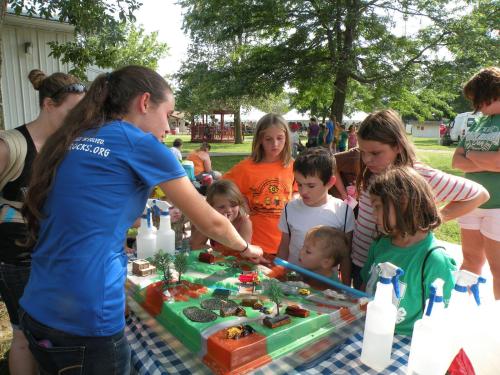
Jessica Rehmann demonstrating where a buffer strip could go and how it would work.
After learning what they can do to help the watershed, Conservation Station visitors get to play the Poo Toss game. In the Poo Toss game, kids learn to properly dispose of dog waste in order to reduce nutrients and bacteria from getting into water. Once they bag the waste, they can toss it into waste buckets to win prizes. The kids enjoy playing the game and like to see other parts of the Conservation Station or come back and do the same activities again! A couple kids kept coming back with more friends to replay the Poo Toss, or see the Enviroscape and Rainfall Simulator!

Kids trying their hand at the Poo Toss to win prizes from the treasure chest with intern Megan Koppenhafer and staffer Ben Schrag.
While the Enviroscape and Poo Toss were the main activities I was involved with, the Conservation Station offers multiple other learning opportunities, as well. The Rainfall Simulator includes parcels of land that show different land management practices, including no tillage, minimum/conservation tillage, intense tillage, cover crops, urban environment (pavement), and a green roof. A rain machine mists the trays, and there are jars below to collect the surface runoff as well as water that infiltrates (soaks into the land). The jars show the amount and the cleanliness of the water that comes from each plot. Inside the Conservation Station trailer, people can walk through the Learning Lab and check out fun Water Rocks! videos and posters about conservation practices and water quality.

Top: Brian Stout presents the rainfall simulator lesson to a group of kids and adults – we talk to people of all ages at county fairs! Below: Kids checking out videos and posters in the Learning Lab, inside the Big Conservation Station trailer.

We invited one enthusiastic girl (in pink) to help teach the Rainfall Simulator (with the help of staffer Ann Staudt) to her cousin, which she excitedly did at the Dallas County Fair.
In the quieter moments of the fairs (to be expected with some smaller counties and extreme heat), I enjoyed watching a mud run, walking around the fairgrounds, climbing a rock wall, and meeting Cy!
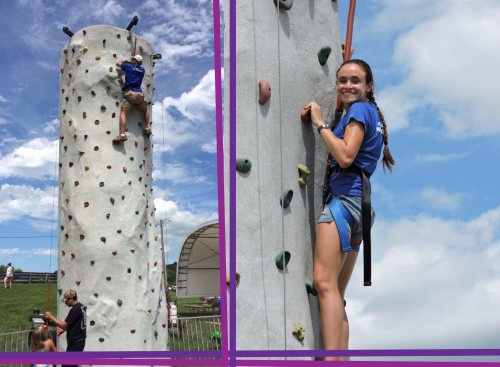
Ben Schrag (left) and Jessica Rehmann (right) scale the rock wall at the Audubon County Fair!

Cy visits the Conservation Station – two thumbs up for conservation!
I hadn’t been to any small county fairs before, so it was an interesting experience to see what they had to offer. I had a great time traveling the state with the Conservation Station and teaching about water quality!
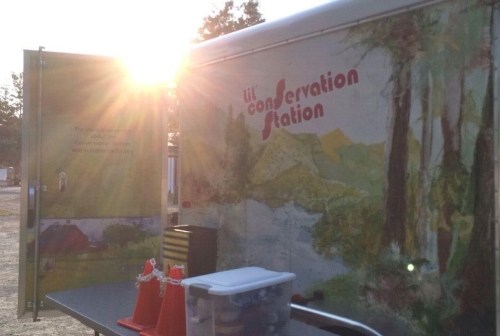
The sun sets after a good day at the Dallas County Fair.
–Jessica Rehmann

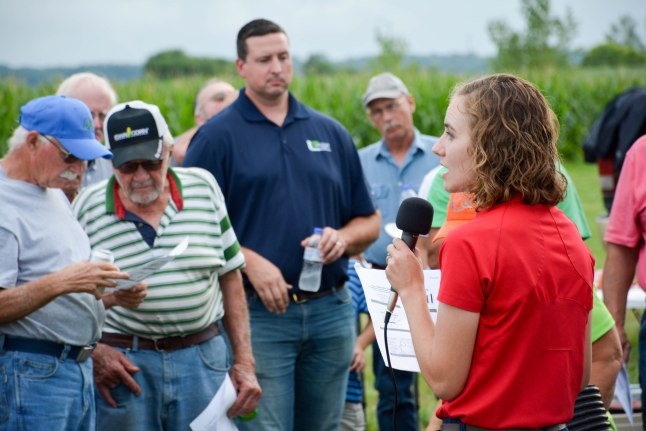
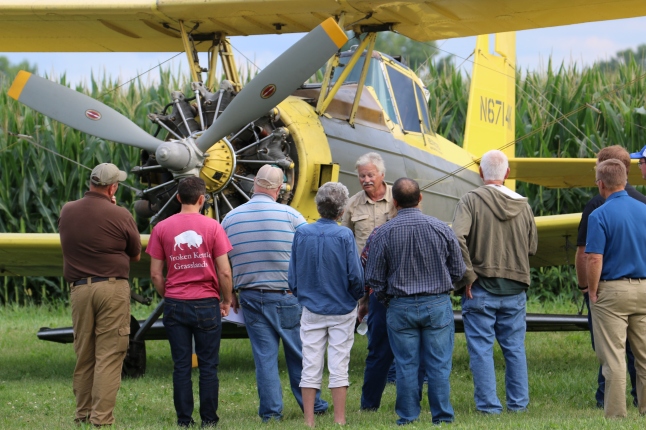
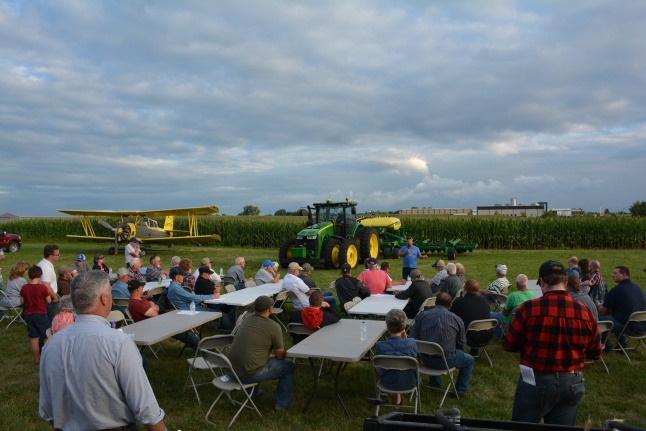
 If you’ve been to an Iowa county fair or attended an Iowa State University (ISU) extension field day covering water quality, conservation, cover crops, edge of field practices or a range of other topics, there’s a good chance you’ve seen or even visited a Conservation Station operated by Water Rocks! and Iowa Learning Farms. Last summer
If you’ve been to an Iowa county fair or attended an Iowa State University (ISU) extension field day covering water quality, conservation, cover crops, edge of field practices or a range of other topics, there’s a good chance you’ve seen or even visited a Conservation Station operated by Water Rocks! and Iowa Learning Farms. Last summer 







 A smaller trailer referred to as Conservation Station 3 was built specifically for outdoor classrooms and other youth activities. Along with a rainfall simulator, it is also equipped with the space to carry enough tables and chairs for students as well as a full complement of displays and activity resources.
A smaller trailer referred to as Conservation Station 3 was built specifically for outdoor classrooms and other youth activities. Along with a rainfall simulator, it is also equipped with the space to carry enough tables and chairs for students as well as a full complement of displays and activity resources.
 Each Conservation Station includes interactive demonstrations that appeal to all backgrounds, ages and walks of life. Games such as the Poo Toss tend to appeal to youngsters but provide tangible lessons about waste runoff that pertains to everyone –whether they live on a farm or in a city. The Watershed Game is another highly visual interactive game that helps make the concepts of a watershed and how pollution moves with water easy to grasp.
Each Conservation Station includes interactive demonstrations that appeal to all backgrounds, ages and walks of life. Games such as the Poo Toss tend to appeal to youngsters but provide tangible lessons about waste runoff that pertains to everyone –whether they live on a farm or in a city. The Watershed Game is another highly visual interactive game that helps make the concepts of a watershed and how pollution moves with water easy to grasp.




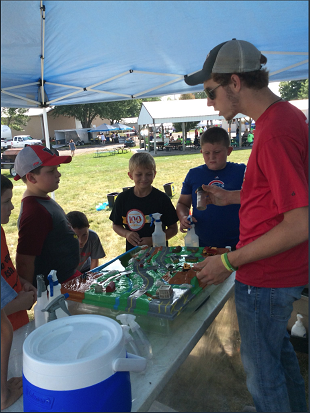 Attending fairs in all ninety-nine counties doesn’t seem much of a feat until you consider that they all take place during the same few weeks each summer. Coordinating and scheduling the teams and equipment, working with tremendous local representatives at each stop, and responding to rain-outs, flat tires, and other hiccups, is a hectic but fulfilling job. At the end of the season, everyone involved gives a sigh of relief and accomplishment, and then looks forward to field days, workshops, and Water Rocks! school programs that fill up the rest of the year.
Attending fairs in all ninety-nine counties doesn’t seem much of a feat until you consider that they all take place during the same few weeks each summer. Coordinating and scheduling the teams and equipment, working with tremendous local representatives at each stop, and responding to rain-outs, flat tires, and other hiccups, is a hectic but fulfilling job. At the end of the season, everyone involved gives a sigh of relief and accomplishment, and then looks forward to field days, workshops, and Water Rocks! school programs that fill up the rest of the year.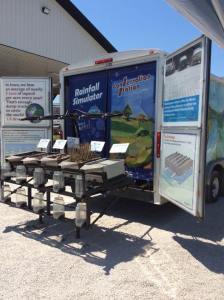 Where else, but at the Conservation Station, can kids win prizes by picking up dog poo (fake) and tossing it into targets? And along the way, learn about animal waste from domesticated pets and livestock, that can pollute the rivers and streams that are a great source of recreation and drinking water throughout the state. The lessons resonate with the parents and grandparents too. We see it in their faces as they lean in to encourage the kids.
Where else, but at the Conservation Station, can kids win prizes by picking up dog poo (fake) and tossing it into targets? And along the way, learn about animal waste from domesticated pets and livestock, that can pollute the rivers and streams that are a great source of recreation and drinking water throughout the state. The lessons resonate with the parents and grandparents too. We see it in their faces as they lean in to encourage the kids.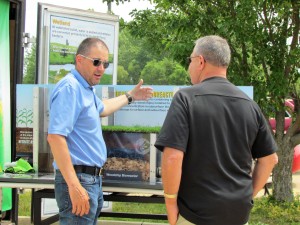 Our new Conservation Station On The Edge trailer also includes working bioreactor and saturated buffer demonstrations that help farmers visualize how these might work on their farms. These structures, which work below the surface and out of view, have proven to reduce nitrate levels by as much as seventy percent.
Our new Conservation Station On The Edge trailer also includes working bioreactor and saturated buffer demonstrations that help farmers visualize how these might work on their farms. These structures, which work below the surface and out of view, have proven to reduce nitrate levels by as much as seventy percent.
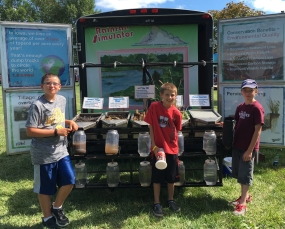 The Conservation Station brings with it a multitude of activities that educate and inspire children, adults and families to think deeper about the world around them. Our rainfall simulator demonstrates the impacts of land management choices on water quality. Our hands-on, interactive activities and games emphasize that, if everyone does their part, we can all make a difference in water quality in Iowa and beyond.
The Conservation Station brings with it a multitude of activities that educate and inspire children, adults and families to think deeper about the world around them. Our rainfall simulator demonstrates the impacts of land management choices on water quality. Our hands-on, interactive activities and games emphasize that, if everyone does their part, we can all make a difference in water quality in Iowa and beyond.













